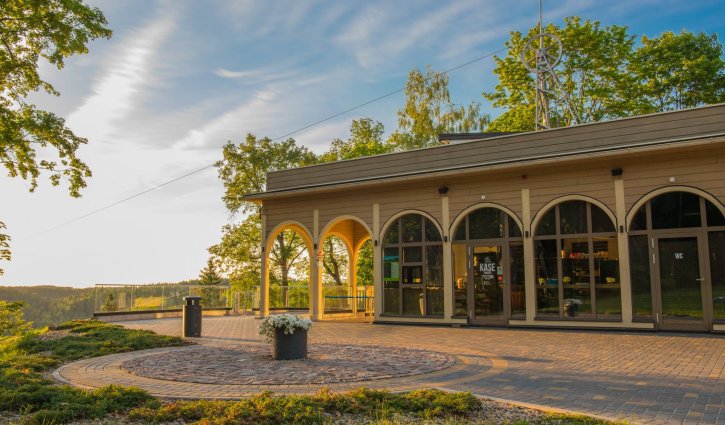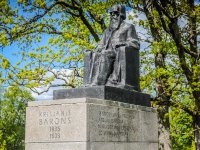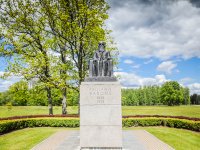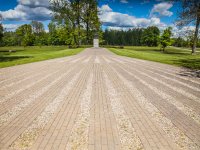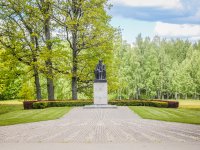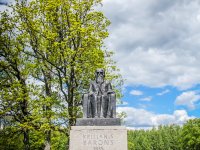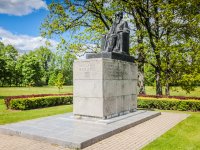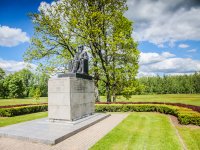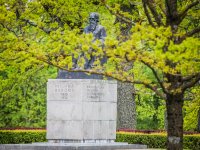
Monument to Krišjānis Barons was made by the sketches of the sculptor Teodors Zaļkalns (1937; 1939). The monument was erected in 1985 in honor of Krišjānis Barons 150th anniversary. The architect - Edvīns Vecumnieks.
| Address | At the crossroads of Kr. Barona and Pils iela, Sigulda |
| Coordinates | 57.162782 24.855448 |
| Phone | +371 67971335 |
| info@sigulda.lv | |
| www | www.tourism.sigulda.lv |
The man calmly observing life’s daily rhythms is none other than Krišjānis Barons, fondly referred to as the father of Dainas by the Latvian people. One of his greatest contributions to Latvian culture and history is in his work cataloging Latvian folklore.
Krišjanis Barons was born in Kurzeme/Kurland in 1835. He later lived with his sister in Dundaga where he began his schooling. He went to high school in Jelgava and attended the University of Tērbata, (now Tartu), where he met Krišjanis Valdemars and Juris Alunāns. Together they formed a student group fostering national pride which later became known as the New Latvians.
Krišjanis Barons led a long and colorful life. He was one of the founders and contributors of the “Pēterburgas Avīze”/ The Paper of Petersburg. He worked as an interpreter in the educational ministry of Petersburg and was a home tutor to wealthy families in addition to working in the field of linguistics. He wrote popular science articles whose style laid the foundation for current standards. He could also be considered the founding father of national geography because, after traveling on foot from Terbata to Dundaga in 1859, he wrote the first geography book in Latvian titled "Describing our fatherland.”
Barons immortalized his name through his valiant efforts in gathering and organizing what is known as the Collection of Latvian Dainas. Dainas are short, rhythmical limericks usually consisting of four lines. He spent nearly 25 years in this process. Day in and day out, he would rise early (sometimes as soon as 5 am in the summer) and work until lunch. After, he would take a walk only to return home and resume his work until nightfall.
To effectively catalog all the collected texts, he created his own method and system of organization. Each limerick was written on a separate piece of paper and then filed in a special cabinet. A sketch by Barons himself illustrates this cabinet, built-in Moscow and now known as the famous "Dainu skapis” or Folksongs Cabinet. It has 70 drawers each with 20 sections and is now housed at the Science Academy.
During his lifetime, his studies and work took Krišjanis Barons to live in many places. These included Dundaga, Tērbata (now – Tartu), Petersburg, Moscow, and Riga but his last summer of 1922 was spent in Turaida in a beautiful place near the banks of the Gauja. His daughter in law Līna recalls: 'Dad loved nature and these surroundings gave him plenty of nature's beauty. His first walk in the morning was to Gutman's cave. He'd drink some clear spring water, and would also fill a white can to take water home. If the sun shone after breakfast he'd go for a walk and disappear for hours. This is when he climbed the hills. He'd often choose steep trails over roads.'
Krišjanis Barons died on March 8th of 1923 and was laid to rest in The Great Cemetery in Riga. This monument was erected in 1985 to commemorate his 150th birthday. The architect was Edvīns Vecumnieks and it was made after a design by the sculptor Teodor Zalkalns.






